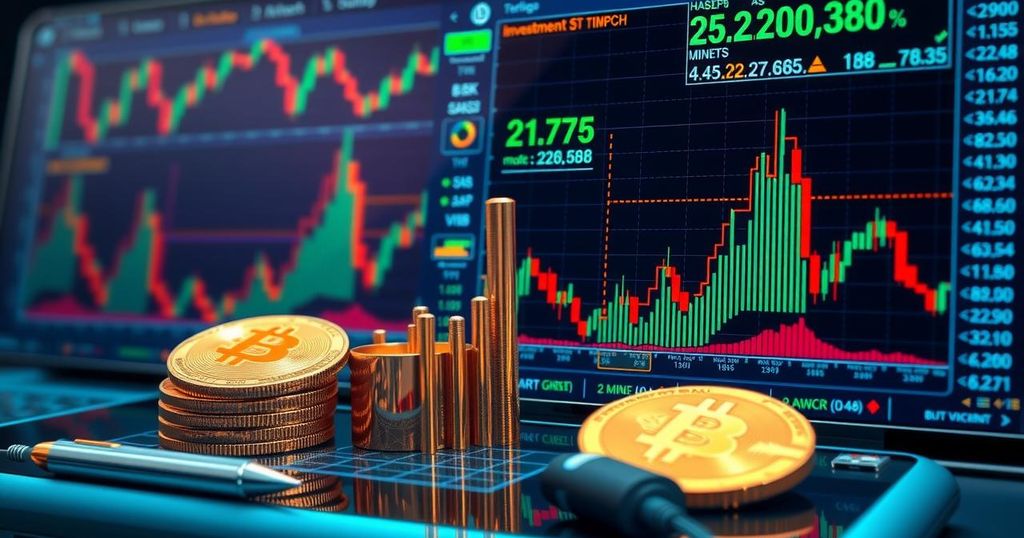Santa Claus Rally: Evaluating High Tech Stocks Versus Cryptocurrency Investments
Despite a recent Federal Reserve rate cut, Bitcoin experienced a significant price drop, alongside NASDAQ tech stocks, raising questions about the likelihood of a Santa Claus rally. Historically, stocks tend to see seasonal price increases during this time, and cryptocurrencies also benefit from year-end gains, although with greater volatility. Analysts suggest that historical data shows promise for both sectors, yet caution remains prudent due to fluctuations in valuations and potential losses.
The recent Federal Reserve rate cut has not led to the expected positive outcomes in the Bitcoin market. Instead, Bitcoin experienced a substantial decline, dropping by as much as 15% at its worst, and maintaining a 3.5% decrease over the preceding month. Concurrently, the NASDAQ Composite index fell by 3% over the same timeframe, prompting speculation about the potential for a traditional Santa Claus rally this holiday season.
Market fluctuations may reflect a much-needed pause following significant gains earlier in the month. Dominic Pappalardo, Chief Multi-Asset Strategist at Morningstar Investment Management, indicated that “Today’s extreme market reaction is being driven by today’s extremely rich valuations across risk assets.” This suggests that the elevated valuations present various risks for investors. Moreover, the Fed’s recent guidance indicating fewer future rate cuts has contributed to the market’s restrained enthusiasm, with Pappalardo noting that “The move in equity markets can be attributed to the Fed’s updated outlook for fewer cuts in 2025.”
Historically, statistics show an impressive 79% probability that U.S. stocks will experience a Santa Claus rally, characterized by an average rise of approximately 1.3%. However, the NASDAQ typically records more pronounced gains or losses than the broader stock market, and the volatility experienced since the pandemic has heightened this trend.
Cryptocurrencies, including Bitcoin, have also demonstrated a propensity for seasonal gains during the holidays, often surpassing stock returns. For instance, last year Bitcoin registered a 4.87% increase during the holiday season, while the NASDAQ’s growth was minimal at 0.46%. Nevertheless, caution is warranted due to the potential for greater losses in altcoins compared to stocks, as the preceding year highlighted, wherein Bitcoin sustained a -0.61% decrease while the NASDAQ gained slightly at 0.04%.
As year-end 2024 approaches, both tech stocks and Bitcoin appear well-positioned for long-term growth supported by the recent market rally. Typically, the last few days of December and the beginning of January often see a bullish trend in both sectors. Historically, Bitcoin tends to exhibit much larger swings compared to stock movements, indicating that investors should remain vigilant in their strategies for capitalizing on potential gains during this time.
The concept of a Santa Claus rally refers to the tendency for financial markets to rise in the last week of December through the first two trading days in January. This positive trend is fueled by various factors, including year-end portfolio adjustments, increased consumer spending during the holidays, and heightened investor sentiment. The volatility within both the cryptocurrency and tech stock markets has become more pronounced over recent years, particularly following the pandemic, thus influencing investment decisions during this seasonal period. The interplay between central bank policies, such as rate cuts by the Federal Reserve, and market valuations has critical implications for both asset classes.
In summary, despite recent downturns, there remains a significant historical precedent for a Santa Claus rally in both tech stocks and cryptocurrencies that could yield substantial returns for investors. Market dynamics, including interest rate adjustments and valuation levels, can profoundly influence outcomes. Consequently, investors should weigh these elements when progressing into year-end trading, considering both the volatility and potential for gains in the current economic environment.
Original Source: cryptopotato.com








Post Comment